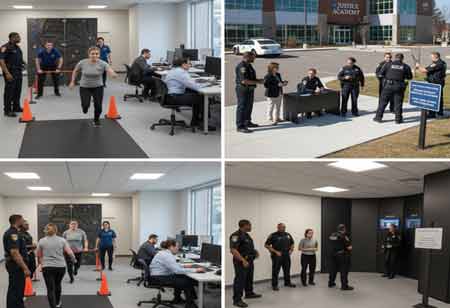THANK YOU FOR SUBSCRIBING
Be first to read the latest tech news, Industry Leader's Insights, and CIO interviews of medium and large enterprises exclusively from Gov CIO Outlook
THANK YOU FOR SUBSCRIBING

By
Government CIO Outlook | Thursday, October 30, 2025
Stay ahead of the industry with exclusive feature stories on the top companies, expert insights and the latest news delivered straight to your inbox. Subscribe today.
The landscape of modern policing is increasingly documented. From body-worn cameras (BWCs) and dashcams to stationary surveillance systems, law enforcement agencies are capturing an unprecedented volume of video data. This surge in digital evidence has brought a parallel rise in demand for public transparency, driven by open records laws and a community desire for accountability. However, this demand exists in a delicate balance with the fundamental right to privacy. Releasing raw footage is rarely an option, as it often contains sensitive and personally identifiable information (PII) of victims, witnesses, minors, and uninvolved bystanders.
This is where video redaction—the process of obscuring sensitive information within video and audio files—becomes a critical, non-negotiable function. Over the past two decades, the methodology for performing this task has undergone a profound transformation, evolving from painstaking manual labor to a high-speed, technologically advanced process driven by artificial intelligence.
The Manual Era: A Frame-by-Frame Bottleneck
In the early days of digital video evidence, redaction was an entirely manual, labor-intensive endeavor. It was a task that fell to video technicians, investigators, or IT staff, requiring them to sit at a workstation with general-purpose video editing software. The process was granular and grueling.
An analyst would load a video file and meticulously scrub through it, often frame by frame. Upon identifying a face, license plate, home address on a building, or a computer screen displaying personal data, they would have to apply an obscuring effect manually—typically a blur filter or an opaque black box. This wasn't a one-time "click and forget" action. The analyst had to "keyframe" the redaction, manually adjusting the box's position, size, and shape in subsequent frames to track the moving object or person.
For a single 10-minute video clip featuring multiple individuals in a dynamic, unstable environment (like an officer walking through a crowd), this process could take many hours, sometimes even a full day's work. The workflow was linear, inefficient, and created a massive operational bottleneck. Agencies found themselves with a growing backlog of video evidence required for court discovery or public release, but with an equally growing deficit of person-hours to process it. The cost was not just in time and resources; it was in the significant potential for human error. Fatigue could easily cause an analyst to miss a face in a crowd or a reflection of a victim's ID in a window, leading to a critical privacy breach.
The Catalyst for Change: A Deluge of Data
The widespread adoption of body-worn cameras marked the tipping point. Suddenly, it wasn't just a few dashcam videos from specific incidents that needed processing. Agencies were now generating thousands of hours of footage every single day from hundreds of officers. The manual redaction model didn't just bend under this new weight; it broke.
Simultaneously, the legal and social environment was shifting. Public records requests for BWC footage became routine, and court-mandated deadlines for evidence disclosure grew stricter. Agencies were caught between the public's right to know and the legal imperative to protect privacy. The sheer scale of the data made the old way impossible. It was clear that a technological leap was necessary to manage data flow, meet legal obligations, and maintain public trust.
The Dawn of Automation: Machine Learning Takes the Wheel
The solution emerged from the fields of artificial intelligence and machine learning. Instead of having a human manually find and track objects, new platforms were developed to automate this process. This shift from manual to machine learning represents the single most significant evolution in the history of video redaction.
Modern redaction systems are powered by sophisticated computer vision models trained on vast datasets to identify specific objects with exceptional speed and accuracy. When an analyst uploads a video, the system automatically scans every frame, detecting and tagging relevant elements. Standard models are pre-trained to recognize common personally identifiable information (PII), such as faces, bodies, and license plates. At the same time, advanced systems can be customized to identify user-defined objects, such as agency-issued devices, tattoos, or credit cards. Once detected, the AI employs intelligent tracking to “lock on” to each object, applying the chosen redaction effect—blur, pixelation, or masking—throughout the video, even as the object moves or becomes partially obscured.
The evolution of redaction technology extends to audio, with Natural Language Processing (NLP) enabling automatic transcription and searchable audio redaction. Analysts can quickly locate and censor sensitive terms such as names, addresses, or identification numbers without manually reviewing the entire recording. Significantly, automation enhances rather than replaces human oversight. The AI handles the labor-intensive tasks, producing a redacted draft within minutes, which human analysts then review for quality assurance—correcting minor errors or false positives as needed. This technological leap has transformed video and audio redaction from a time-consuming, error-prone process into a streamlined, efficient, and scalable workflow for law enforcement agencies.
Agencies can now process and release video evidence in a fraction of the time, improving transparency and responsiveness to public records requests. Detectives and officers are freed from the tedious task of video editing, allowing them to focus on core investigative duties. Most importantly, the consistency and accuracy of machine learning reduce the risk of human error, providing greater protection for citizen privacy.
The evolution from manual redaction to machine learning is more than just a technological upgrade. It is a foundational change that enables law enforcement to navigate the complex demands of the 21st century—balancing the critical needs for transparency, accountability, and the unassailable right to privacy in an increasingly documented world.
I agree We use cookies on this website to enhance your user experience. By clicking any link on this page you are giving your consent for us to set cookies. More info

However, if you would like to share the information in this article, you may use the link below:
www.govciooutlookapac.com/news/the-evolution-of-video-redaction-in-law-enforcement-nid-2579.html



